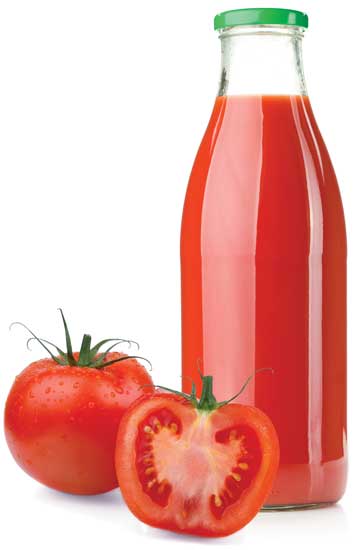Tastier tomato juice; Gen Z may be hard to please
NEWS
 A tastier tomato juice
A tastier tomato juice
Processed tomato consumption has increased markedly over the past 50 years. However, tomatoes commonly used for processed tomato products are generally not high in flavor quality. A recent Journal of Food Science study investigated whether a premium Florida plum tomato (Garden Gem) had the potential to produce a high quality processed juice product.
The Garden Gem and a typical grocery store plum tomato variety (Roma) were thermally processed into tomato juices without any additives. The two pilot products and a popular commercially available tomato juice (low sodium with sugar and flavor added) were compared using sensory evaluation and instrumental analysis, then rated by a panel of 19 consumers.
Garden Gem juice was rated significantly higher for liking, tomato flavor, and sweetness, with elevated levels of three sweet- and fruity-related aroma compounds: 6-methyl-5-hepten-2-one, linalool, and β-ionone. The profile of the Roma tomato juice was similar to that of Garden Gem juice, except it contained substantially lower amounts of hexanal and 2-isobutylthiazole. The commercial tomato juice contained a high level of the Maillard reaction-related notes furfural and dimethyl sulfide, and the least amount of green-related notes (hexanal, E-2-hexenal and Z-2-heptenal). The compound β-ionone (fruity note) was not detected in either the commercial or Roma juice.
“This proof of concept study demonstrates that high flavor quality tomatoes can be used to create better tasting processed tomato products,” concluded the researchers. “The study also demonstrates how sensory preference can confer a potential market advantage over existing commercial products.”
Prebiotics market invests in innovation
The prebiotic ingredients market, valued at an estimated $4.1 billion in 2017, is projected to grow at a compound annual growth rate (CAGR) of 10.4%, to reach $7.4 billion by 2023, according to a report published by MarketsandMarkets. To expand their product portfolios and attract more consumers, the major players in the food industry are investing in R&D activities that will allow them to provide innovative products at lower prices.
Among the factors driving market growth are the trending adoption of a healthy diet centered on low calories and fat, and the wide application of prebiotics in foods such as lowfat cheeses, sauces, soups, and table spreads.
Food and beverages accounted for the largest share of the market in 2016 on the basis of application, followed by the dietary supplement industry. Among sources, roots accounted for the largest market share, followed by prebiotics sourced from grains. The largest market in 2016 was Europe, characterized by the presence of large-scale prebiotic ingredients manufacturers who launched an increasing number of new, modified prebiotic products, such as lowfat and fortified breads with prebiotic ingredients.
FDA, USDA committed to collaboration
In a move to make the oversight of food more efficient and effective, U.S. Agriculture Secretary Sonny Perdue and Food and Drug Administration (FDA) Commissioner Scott Gottlieb announced a formal agreement to increase interagency collaboration on produce safety and biotechnology activities, while providing clarity to manufacturers.
The agreement is designed to streamline regulatory responsibilities, reduce costs for industry, and use government resources more efficiently to protect public health. It also aims to increase clarity and potentially reduce the number of establishments subject to dual regulatory requirements. For example, a facility that produces chicken noodle soup and tomato soup is currently subject to regulation by both agencies. The agreement tasks both organizations with identifying ways to reduce inspection inefficiencies while upholding safety standards for dual-jurisdiction facilities.
“Secretary Perdue and I share a deep commitment to further strengthening our nation’s food safety system in the most effective and transparent way,” says Gottlieb. “Over the last several months, the secretary and I have worked closely and identified several areas where we can strengthen our collaboration to make our processes more efficient, predictable, and potentially lower cost to industry while also strengthening our efforts to ensure food safety. This agreement not only formalizes this ongoing coordination, but presents a great opportunity to expand those efforts through better integration and increased clarity to the agriculture and food processing sectors.”
 Gen Z may be hard to please
Gen Z may be hard to please
Generation Z, individuals born between 1997 and the present, are growing up with a greater emphasis on the flavor of food, as well as its functional and nutritional value, making them more challenging for food marketers to reach, according to a new study by The NPD Group. Comprising 27% of the U.S. population, Gen Zs are unintentional foodies who understand the purpose of food and how it fits into a well-lived life. As a result, they expect that food and food brands will follow their needs and not the other way around.
Like the Millennials, Gen Zs prefer food and beverages with transparent labeling and an absence of artificial ingredients; they are skeptical of big brands and too many label claims. They also seek personalization, engagement, and fluidity, such as portable foods, to meet the needs of their busy lives.
“The more I study trends in retailing, foodservice, and eating patterns, the more I become convinced that the macro themes emerging in consumption behavior are generationally driven,” says David Portalatin of NPD, author of Eating Patterns in America. “Gen Zs will be a seismic force for the food industry as they emerge into adulthood under more prosperous economic circumstances, yet with their own differentiating set of values.”
Fish are champs at fighting cancer
Omega-3s from fish pack a stronger punch than flaxseed and other oils when it comes to cancer prevention, according to a study in the Journal of Nutritional Biochemistry. When mice with a highly aggressive form of human breast cancer were exposed to marine-based omega-3s, the size of their tumors was reduced by 60% to 70%, and the number of tumors was reduced by 30%. Higher doses of the plant-based fatty acid were required to deliver the same impact.
The study, authored by David Ma, professor in the Dept. of Human Health and Nutritional Sciences at the University of Guelph, is the first to compare the cancer-fighting potency of plant- versus marine-derived omega-3s on breast tumor development. Omega-3s prevent and fight cancer by turning on genes associated with the immune system and blocking tumor growth pathways. “In North America, we don’t get enough omega-3s from seafood,” says Ma, “so there lies an opportunity to improve our diet and help prevent the risk of breast cancer.”
Based on the doses given in the study, Ma said humans should consume two to three servings of fish a week to have the same effect. Additionally, supplements and functional foods, such as omega-3 eggs or DHA milk, can offer similar cancer prevention effects.
News Bites
• AAK is making investments to modernize and improve capacity at its Louisville, Ky., plant.
• Archer Daniels Midland opened an 8,900-square-foot innovation center at the Biopolis research hub in Singapore.
• Cargill has signed a joint venture agreement with Puris, the largest North American producer of pea protein, to accelerate a new wave of sustainable, plant-based foods.
• The Cold Pressure Council launched a High Pressure Certified seal for use on HPP food and beverage packaging. The seal certifies that the item has been properly processed and independently verified for safety.
• The European Commission authorized the use of stacked traits in Pioneer brand Plenish high oleic soybeans for food and feed.
• Firmenich has entered into an exclusive partnership with Blue Marble Biomaterials, a leading U.S. biotechnology company specializing in natural and sustainable ingredients.
• Grain Processing received Non-GMO Project Verification at its Washington, Ind., production facility for maltodextrin and corn syrup solids.
• Icon Foods earned its Safe Quality Food (SQF) Level 2, Oregon Kosher, and Non-GMO Project Verification certifications at its new headquarters in Portland, Ore.
• Ingredion has entered into a partnership with The Hatchery Chicago, a non-profit food business incubator, as part of Ingredion for Emerging Business, an initiative to help emerging food and beverage companies turn innovative ideas into on-trend, scalable products.
• International Flavors & Fragrances broke ground on a new plant in Sri City, in the State of Andhra Pradesh in India. The plant is expected to be commercialized in December 2019.
• Keurig Green Mountain has struck a deal to merge with Dr Pepper Snapple Group. The new company will be called Keurig Dr Pepper.
• Mars Chocolate and Wrigley Canada are operating as one business, known as Mars Wrigley Confectionery, part of Mars Canada.
• McCormick & Company was named the 23rd most sustainable corporation on the 2018 Corporate Knights Global 100 Sustainability Index, released at the World Economic Forum in Davos, Switzerland.
• Nestlé has agreed to sell its U.S. confectionery business to Italy’s Ferrero for $2.8 billion.
• Sonoma Creamery, makers of the Cheese Crisps and Mr. Cheese O’s lines of snacks, and Laiki, makers of better-for-you rice crackers, have announced a strategic partnership.
• Vintage Wine Estates, a privately held wine company, acquired Tamarack Cellars, a pioneering winery in Walla Walla, Wash.
 Margaret Malochleb,
Margaret Malochleb,
Associate Editor
[email protected]
